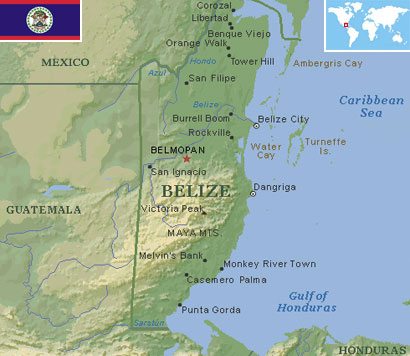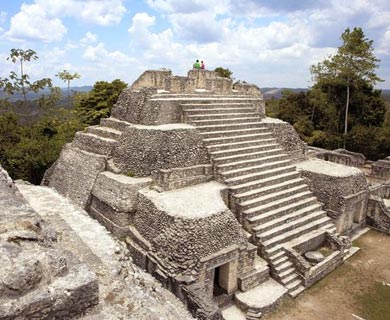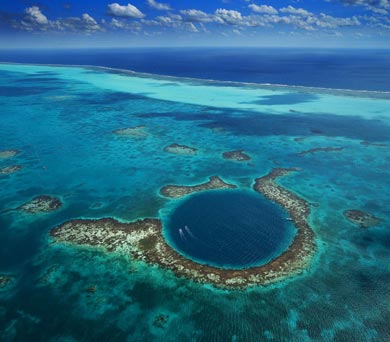Belize
Country statistics

Land area: 8,803 sq miles (22,800 sq km)
Total area: 8,867 sq miles (22,966 sq km)
Population (2010 est.): 314,522 (growth rate: 2.1%); birth rate: 26.8/1000; infant mortality rate: 22.5/1000; life expectancy: 68.2; density per sq km: 13
Capital City: Belmopan
Monetary unit: Belize dollar
Languages: English (official), Spanish, Mayan, Garifuna (Carib), Creole
Ethnicity/race: mestizo 48.7%, Creole 24.9%, Maya 10.6%, Garifuna 6.1%, other 9.7%
Religions: Roman Catholic 50%, Protestant 27% (Pentecostal 7%, Anglican 5%, Seventh-Day Adventist 5%, Mennonite 4%, Methodist 4%, Jehovah's Witnesses 2%), none 9%, other 14% (2000)
Country introduction

Belize is a country located on the north-eastern coast of Central America and is bordered to the north by Mexico, south and west by Guatemala, and to the east by the Caribbean Sea.
Within the borders of this small country there is a remarkably diverse landscape. The northern interior region tends to be flat and swampy, with many lagoons and is where much of the nation's sugarcane, citrus and cattle are produced. Eighteen major rivers and many perennial streams drain these low-lying areas.
The Belize coast stretches some 297 km (185 miles) and along its entire length lies the Belize Barrier Reef, the second largest barrier reef in the world. The reef lies 16 km to 64 km (10 to 40 miles) offshore and inside the reef's protective barrier lie over 200 small islands or cayes. Westward from the northern coastal areas, the terrain changes from mangrove swamp to tropical pine savanna and hardwood forest.
The southern regions of the country are distinguished by the Maya Mountains and are crossed with numerous rivers. The mountains rise to heights of about 1,100 m (3,608 ft), with the highest point being Doyle's Delight at 1,124 m (3,687 ft) in the Cockscomb Mountains. Covered with shallow, highly erodible soils of low fertility, these heavily forested highlands are very sparsely inhabited. Some 70% of the nation is covered in forest and much of the tropical jungle and rainforest is now under protection by the government.
The interlocking networks of rivers, creeks, and lagoons have played a key role in the historical geography of Belize. The largest and most historically important river is the Belize River, which drains more than one-quarter of the country as it winds along the northern edge of the Maya Mountains across the center of the country to the sea near Belize City. Also known as the Old River, the Belize River is navigable up to the Guatemalan border and served as the main artery of commerce and communication between the interior and the coast until well into the 20th century. Other historically important rivers include the Sibun River, which drains the north-eastern edge of the Maya Mountains, and the New River, which flows through the northern sugar-growing areas before emptying into Chetumal Bay. Both of these river valleys possess fertile alluvial soils and have supported considerable cultivation and human settlement.
The culture

The first inhabitants in what is now Belize were the Maya. The country was an important part in the great Mayan Empire, an empire which was possibly the most sophisticated civilization in the ancient Americas. Other territories inhabited by the Maya included modern day Southern Mexico, Guatemala, El Salvador, and Honduras. This once great civilization reached their peak in the 6th, 7th, and 8th centuries AD, but mysteriously declined by the 14th century. By the time the Spanish arrived in the 16th century, Maya presence was barely felt. Today, about 10% of the population of Belize are Maya. At the peak of the vast Mayan empire, archeologists estimate that 1 to 2 million Mayans lived within the borders of Belize.
Modern day Belize is comprised of a harmonious combination of Maya, Mestizo, Creole, Garifuna, East Indian, Mennonite, Arab and Chinese, as well as a number of European and American influences, a combination which has resulted in one of the happiest and most peaceful countries in the region. English remains the official language, but the most diverse language in Belize is Kriol (Belizean Creole), with other cultural languages spoken such as Garifuna, Mandarin, Spanish and Maya dialects of Kekchi, Mopan and Yucatec.
As there is such a diverse culture in Belize, each have their celebrations and religions. With a large percentage of the population being Christian, Easter and Christmas are important times for Belizeans. Drawing on many different cultural influences, Christmas is celebrated with a range of multi-racial rituals including old European traditions like decorating a Christmas tree and baking fruitcake, as well as other traditions like Creole cooking and Garifuna dancing. Due to a high level of racial harmony and tolerance, the people of Belize are free to celebrate various religious and ethnic holidays in relative peace. One tradition occurs on the 1st and 2nd of November, All Saint's Day and All Souls Day. On this day, huge feasts are prepared for ancestors. Late evening, these meals are set on tables along with candles in the houses of those who have lost their loved ones. If the food is gone in the morning, the people believe that their ancestors came for the food. Another tradition is The Feast of San Luis, which is celebrated during Easter. Traditional dances such as the Cortes Dance and the Deer Dance are held. The Cortes Dance uses drums, flutes, and rattles to dramatize the combined forces of the church and army during the European conquest. The Deer Dance is accompanied by the marimbas and symbolizes the important relationship between humanity and nature.
The diversity of the culture of Belize is reflected in the wide array of culinary choices. The food in the country ranges from spicy to cool, and many of the dishes are savory and rich, made with local game that can be found in the plains and forests that cover the land. There is even more selection to choose from, when local dishes from neighboring Central American countries and international cuisines such as Chinese and Nigerian are added to the mix.
Attractions & landmarks

Belize has a lot to offer tourists looking for an unforgettable adventure. There is a tremendous variety of attractions available that include white sand beaches, dense rainforests and the Barrier Reef.
An important part of Belize history are the Mayan ruins, a legacy of outstanding palaces and temples. El Caracol, located 40 km (24 miles) south of the town of San Ignacio is among the best Mayan sites in the country and is truly an impressive sight to behold. The giant climbable temples built in the foothills of the Maya Mountains are at an elevation of 500 m (1,640 ft) above sea-level and for those who reach the top will be rewarded with a magnificent view of miles of protected Chiquibul forest.
A few hours drive from El Caracol, is the the Barton Creek Caves, a large river cave possibly over 7 km (4.5 miles) long. The cave system consists of giant passages covered with numerous large speleothems over a navigable river. Visitors to the cave system have to enter by canoe, which are equipped with high-powered lights to help with visibility once inside. It is believed that these caves were once used by the the Mayans for ritual ceremonies as the remains of at least 28 humans and many artefacts have been found within. The magical and mystical caves are spectacular to explore and truly an unforgettable experience.
The Belize Barrier Reef is a series of coral reefs about 290 km (180 miles) long and no more than 40 km (25 miles) off the coast. Considered among the top Belize tourist attractions, the Belize Barrier Reef is the largest reef system in the Western Hemisphere and second only in size to the Great Barrier Reef in Australia. The reef is home to thousands of species of plants and animals with an estimated of only 10% of these discovered. Activities available near the reef include scuba diving, snorkeling, fishing, kayaking and sailing. all an unforgettable experience. The top scuba diving destination is at the Blue Hole, an underwater sinkhole that measures about 304 m (1,000 ft) across, with a depth of more than 121 m (400 ft).
The Belize beaches are among the top tourist attractions. Placencia, which is a town 22 km (14 miles) offshore from Dangriga on a small peninsula, is particularly the best for a beach vacation. Placencia boasts nearly 26 km (16 miles) of amazing stretches of white sand, especially in South Water Caye where mangroves, vast seagrass beds, shallow coral reefs, and coral mounds can be found. It is also home to large marine life like turtles and eagle rays, colorful coral, and small fishes.